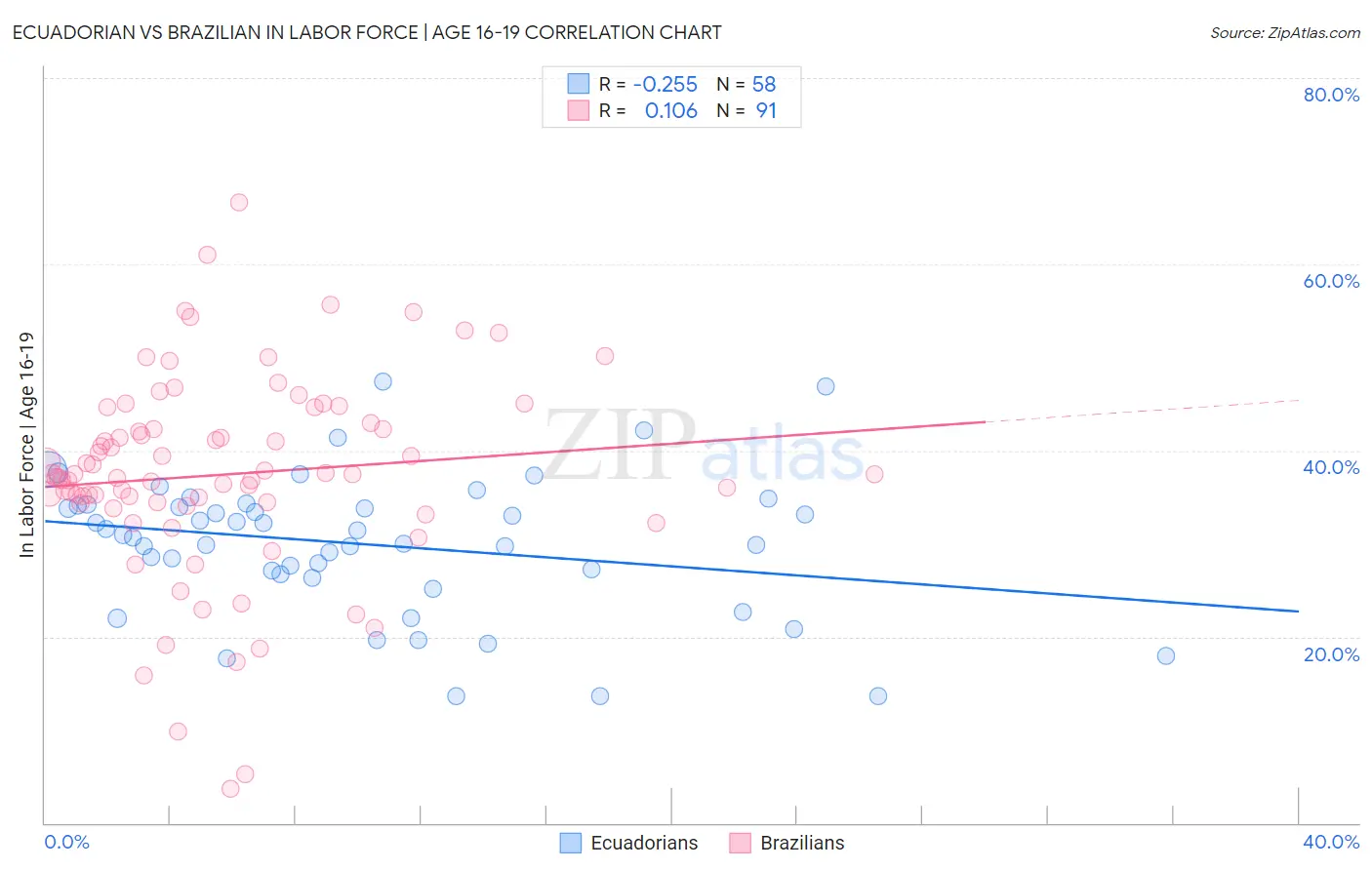Ecuadorian vs Brazilian In Labor Force | Age 16-19
COMPARE
Ecuadorian
Brazilian
In Labor Force | Age 16-19
In Labor Force | Age 16-19 Comparison
Ecuadorians
Brazilians
31.4%
IN LABOR FORCE | AGE 16-19
0.0/ 100
METRIC RATING
320th/ 347
METRIC RANK
37.5%
IN LABOR FORCE | AGE 16-19
88.7/ 100
METRIC RATING
147th/ 347
METRIC RANK
Ecuadorian vs Brazilian In Labor Force | Age 16-19 Correlation Chart
The statistical analysis conducted on geographies consisting of 317,507,621 people shows a weak negative correlation between the proportion of Ecuadorians and labor force participation rate among population between the ages 16 and 19 in the United States with a correlation coefficient (R) of -0.255 and weighted average of 31.4%. Similarly, the statistical analysis conducted on geographies consisting of 323,588,239 people shows a poor positive correlation between the proportion of Brazilians and labor force participation rate among population between the ages 16 and 19 in the United States with a correlation coefficient (R) of 0.106 and weighted average of 37.5%, a difference of 19.5%.

In Labor Force | Age 16-19 Correlation Summary
| Measurement | Ecuadorian | Brazilian |
| Minimum | 13.6% | 3.7% |
| Maximum | 47.4% | 66.7% |
| Range | 33.8% | 63.0% |
| Mean | 29.9% | 37.4% |
| Median | 30.8% | 37.4% |
| Interquartile 25% (IQ1) | 26.7% | 34.3% |
| Interquartile 75% (IQ3) | 34.0% | 43.0% |
| Interquartile Range (IQR) | 7.3% | 8.7% |
| Standard Deviation (Sample) | 7.4% | 10.9% |
| Standard Deviation (Population) | 7.4% | 10.8% |
Similar Demographics by In Labor Force | Age 16-19
Demographics Similar to Ecuadorians by In Labor Force | Age 16-19
In terms of in labor force | age 16-19, the demographic groups most similar to Ecuadorians are Soviet Union (31.4%, a difference of 0.060%), West Indian (31.3%, a difference of 0.23%), Tohono O'odham (31.3%, a difference of 0.35%), Immigrants from Yemen (31.5%, a difference of 0.38%), and Immigrants from Caribbean (31.2%, a difference of 0.48%).
| Demographics | Rating | Rank | In Labor Force | Age 16-19 |
| Hopi | 0.0 /100 | #313 | Tragic 31.8% |
| Cubans | 0.0 /100 | #314 | Tragic 31.8% |
| Immigrants | West Indies | 0.0 /100 | #315 | Tragic 31.7% |
| Filipinos | 0.0 /100 | #316 | Tragic 31.7% |
| Immigrants | Nicaragua | 0.0 /100 | #317 | Tragic 31.6% |
| Immigrants | Yemen | 0.0 /100 | #318 | Tragic 31.5% |
| Soviet Union | 0.0 /100 | #319 | Tragic 31.4% |
| Ecuadorians | 0.0 /100 | #320 | Tragic 31.4% |
| West Indians | 0.0 /100 | #321 | Tragic 31.3% |
| Tohono O'odham | 0.0 /100 | #322 | Tragic 31.3% |
| Immigrants | Caribbean | 0.0 /100 | #323 | Tragic 31.2% |
| Dominicans | 0.0 /100 | #324 | Tragic 31.2% |
| Immigrants | China | 0.0 /100 | #325 | Tragic 31.1% |
| Immigrants | Dominican Republic | 0.0 /100 | #326 | Tragic 31.1% |
| Immigrants | Taiwan | 0.0 /100 | #327 | Tragic 31.0% |
Demographics Similar to Brazilians by In Labor Force | Age 16-19
In terms of in labor force | age 16-19, the demographic groups most similar to Brazilians are Immigrants from Western Europe (37.5%, a difference of 0.030%), Japanese (37.5%, a difference of 0.080%), Paiute (37.5%, a difference of 0.080%), Pakistani (37.6%, a difference of 0.10%), and Sierra Leonean (37.6%, a difference of 0.13%).
| Demographics | Rating | Rank | In Labor Force | Age 16-19 |
| Estonians | 91.7 /100 | #140 | Exceptional 37.7% |
| Syrians | 90.7 /100 | #141 | Exceptional 37.6% |
| Sierra Leoneans | 89.7 /100 | #142 | Excellent 37.6% |
| Pakistanis | 89.5 /100 | #143 | Excellent 37.6% |
| Japanese | 89.3 /100 | #144 | Excellent 37.5% |
| Paiute | 89.3 /100 | #145 | Excellent 37.5% |
| Immigrants | Western Europe | 88.9 /100 | #146 | Excellent 37.5% |
| Brazilians | 88.7 /100 | #147 | Excellent 37.5% |
| Romanians | 87.3 /100 | #148 | Excellent 37.5% |
| Native Hawaiians | 85.0 /100 | #149 | Excellent 37.4% |
| Tsimshian | 84.7 /100 | #150 | Excellent 37.4% |
| Immigrants | Poland | 84.4 /100 | #151 | Excellent 37.3% |
| Immigrants | Sierra Leone | 83.6 /100 | #152 | Excellent 37.3% |
| Arapaho | 81.8 /100 | #153 | Excellent 37.3% |
| Immigrants | Bulgaria | 81.6 /100 | #154 | Excellent 37.3% |